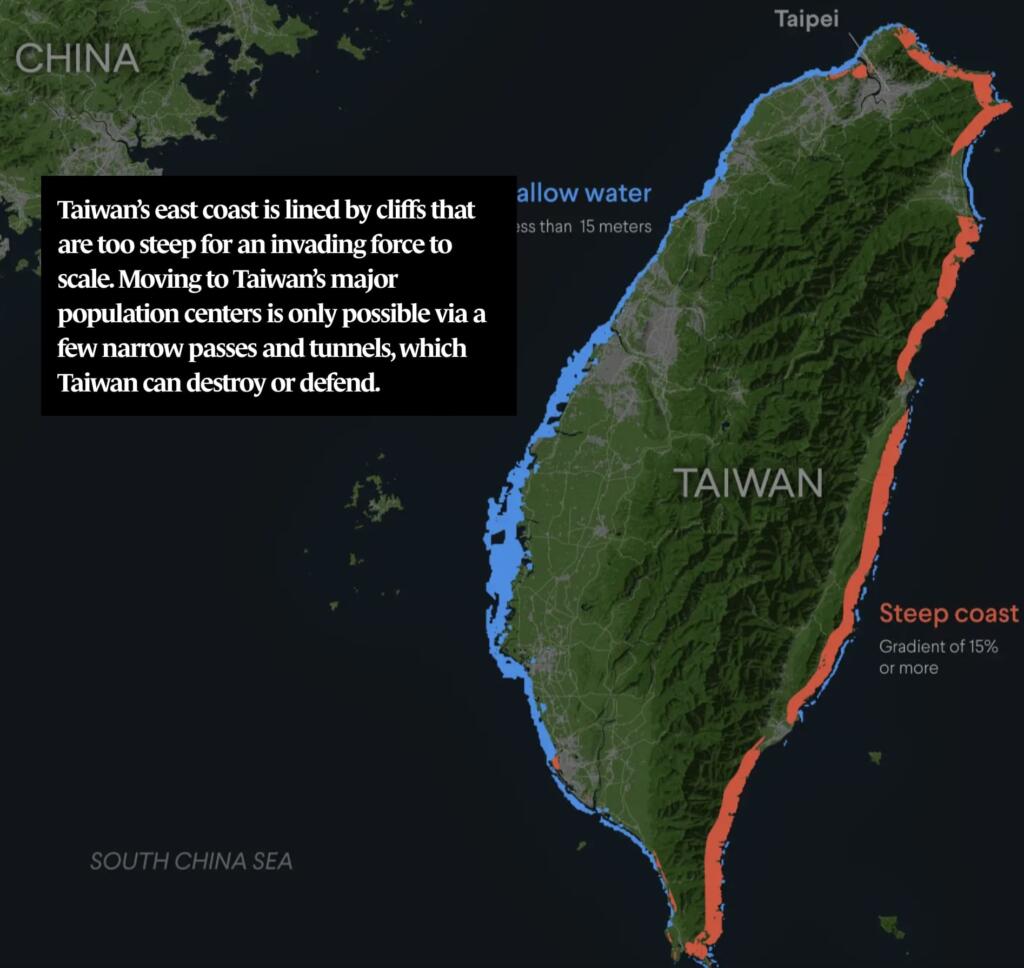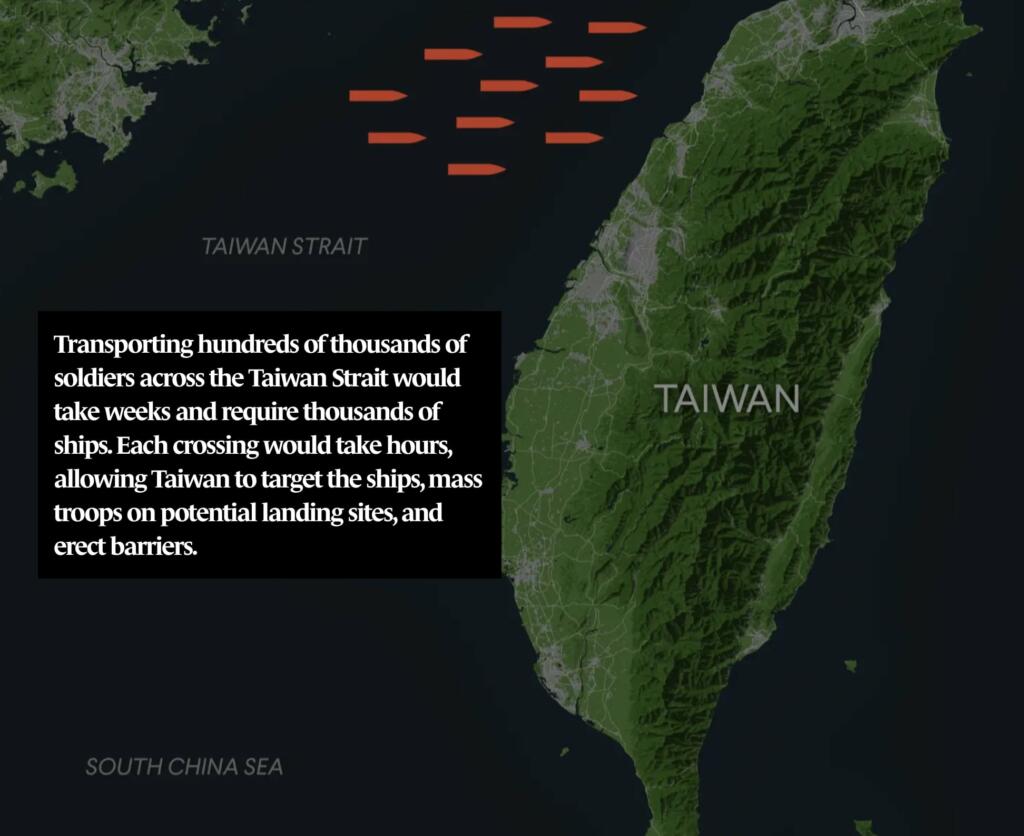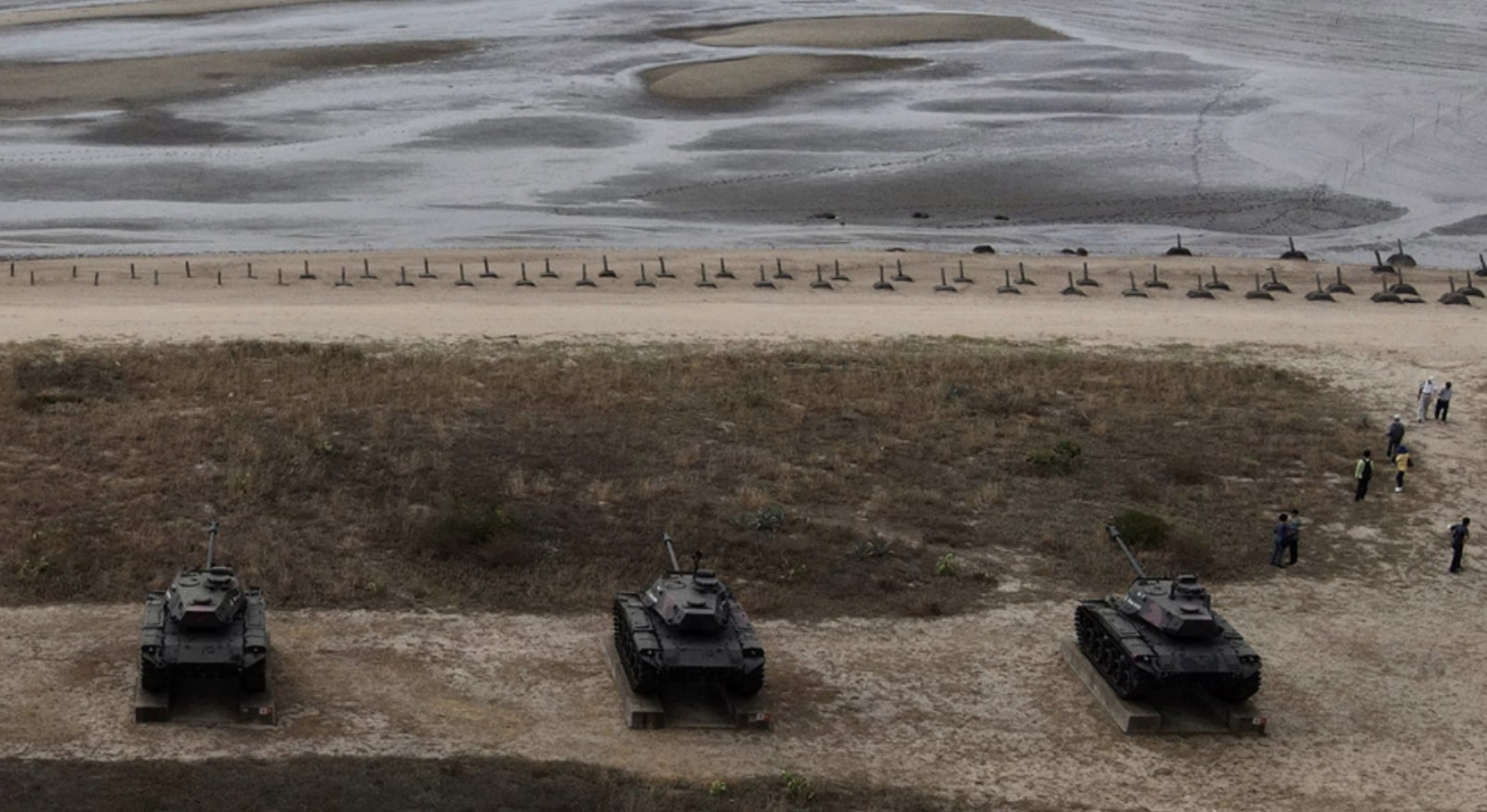The Council of Foreign Relations states the difficulties that China would have attacking Taiwan. Taiwan is a nearly perfect island to defend.
China would need to shift military assets to its eastern coast and undertake other visible preparations for an invasion, which Taiwan and the United States would likely be able to detect.
Even if Chinese troops successfully cross the strait, few deep-water ports and beaches in Taiwan could accommodate a large landing force.
Due to the shallow water, China would have to anchor ships far from Taiwan’s coast and move equipment to the shores slowly, making the ships vulnerable to Taiwanese missiles and artillery.
Taiwan’s east coast is lined by cliffs that are too steep for an invading force to scale. Moving to Taiwan’s major population centers is only possible via a few narrow passes and tunnels, which Taiwan can destroy or defend.












There was a CSIS wargame of a China war with Taiwan.
There is a 3.5 day turn rate in the wargame. The early phases of the war needs to be done hour by hour.
They always start the wargame with China being given a successful sneak attack. The sneak attack destroys a lot of Taiwan’s Navy and Air force.
IF a large sneak attack were to occur in real-life then it would be the result of monumental incompetence.
Ukraine avoided having its air force wiped out when Russia attacked.
Taiwan has mountain bases to protect aircraft.
They did determine that it was critical for Taiwan to destroy China’s amphibious landing ships.
Destroy the landing ships and the invasion always fails.
This was obvious and there has been the recommendation to increase the shipment of anti-ship missiles to Taiwan.
The wargame noted the importance of the US having access to bases on Japan.
The CSIS made recommendations for the hardening of airplane hangers on Japan and Guam to protect airplanes.

Brian Wang is a Futurist Thought Leader and a popular Science blogger with 1 million readers per month. His blog Nextbigfuture.com is ranked #1 Science News Blog. It covers many disruptive technology and trends including Space, Robotics, Artificial Intelligence, Medicine, Anti-aging Biotechnology, and Nanotechnology.
Known for identifying cutting edge technologies, he is currently a Co-Founder of a startup and fundraiser for high potential early-stage companies. He is the Head of Research for Allocations for deep technology investments and an Angel Investor at Space Angels.
A frequent speaker at corporations, he has been a TEDx speaker, a Singularity University speaker and guest at numerous interviews for radio and podcasts. He is open to public speaking and advising engagements.


Also in Beijing’s mind would be, unlike Ukraine and Moscow, Taiwan would not have reservations about blowing the crap out of Beijing and other Chinese cities. Quite a bit of MADness would occur. I do hope that we never see the day, and am happy to see the Taiwanese chose an independence minded president Lai Ching-Te.
Back to the beginning of this thread …
Agree that it will cost a lot, there will be losses in personnel and ships, etc. But if the WWII Allies could successfully invade Normandy, then PRC can do the same if they are willing to pay those costs. I don’t know if Patton actually said [paraphrasing] ‘if oceans and mountains can be overcome, then fixed fortifications can be as well’, but it is true
Agree that Taiwan needs more artillery shells, but not “dumb” rounds ….
They need fire and forget 155 mm. They have Copperhead, but that is not the best solution
Defense against artillery shells is in its infancy – small target, moving fast, etc. This is unlike decades of work to shoot down missiles like Harpoon, Exocet, etc. I doubt PRC warships could interdict or destroy even a small percentage of arty rds aimed at their own ship. As for providing coverage to those ships without advanced radar, control systems, lots of ‘very’ fast surface to air missiles, that would be even less effective
Granted, 155 mm may not immediately sink warships, landing ships, ferries, RORO, etc., but they should be able to severely damage even ‘current build’ warships, which are not built like WWII cruisers and battleships, w/ thick deck and hull armor, etc. If a vessel catches fire, a distinct possibility, it is no longer able to cycle back and forth to pick up and deliver troops, MBTs, IFVs, SP Arty, trucks, fuel, bullets, etc. The crew will be too busy
The ROC army needs ‘next generation’ implementations to handle ships. Some possibilities
M982 Excalibur
Even current GPS Excalibur would be useful in the case where ships, ferries, etc. must anchor off-shore, drive ashore, or dock. Stationary and visible = dead
Excalibur S: RTX had a program to put semi-active laser (SAL) targeting on Excalibur.
Army decided not useful since it required an FO party, etc. to lase the target. Hard to do 40, 80, 100 or more kilometers deep in enemy territory, so a valid point. BUT, SAL would be at least workable for hitting vessels close to shore. And, it not, then …
Excalibur N5: Version [downsized into a 127 mm (5.0 in)] was being considered, to include MMW for fire-and-forget operations. MMW is all-weather and has no need for laser designation, so it could be fire out into the Strait
Excalibur HTK (Hit To Kill): I have seen there was consideration of putting an armor-penetrating warhead on Excalibur, rather than ‘simple’ point detonate. It was to leverage more recent smart weapon designs w/ tri-mode seeker; MMW, IIR, SAL. Even better than the naval variant above – a 5 to 6″ shaped charge could penetrate the exterior of almost any ship and cause a great deal of damage internally.
155 rds are not cheap, and next gen guidance kits would further increase the price, but way cheaper than Harpoons, etc.,
Taiwan could take a page from what Israel, Saudi Arabia and Dubai did w/ the F-15 – pay for the feature and capabilities they wanted. Taiwan could pay RTX directly, up front, to develop what Taiwan needs. No time used convincing Congress, getting appropriations, letting contracts, etc.
Then Taiwan asks the US for export permission, which I think would be forthcoming
Who knows, we might buy the result for our own use, a la F-15EX Eagle II
155 mm BONUS rounds
Not a ‘unitary’ ‘precision’ round in the traditional sense, but at the end of trajectory, the round deploys two sub-munitions, each w/ IIR seekers and EFP warheads, that are ‘precision’
Again, EFP may not sink a ship, or even a repurposed civilian ferry, but battery-level, or even battalion-level, salvos should significantly damage modern build ships. Those are hard to sink, but much easier to damage than WWII era cruisers and battleships, which had deck armor, relatively heavy superstructure armor, etc.
In addition to buying U. S. Harpoons, Taiwan also makes its own missiles:
“Among the types of missiles to be delivered in the next few years will be mobile coastal defense cruise missiles, an air defense system, the Wan Chien air-to-ground missile system and the Hsiung Feng II-E (HF-2E) land attack cruise missile system. The Wan Chien system will be completed next year and the HF-2E in 2025.”
See:
https://aviationweek.com/defense-space/missile-defense-weapons/taiwan-missile-delivery-seen-hitting-new-high-more-1000-24
More anti-ship missiles you say?
“Taiwan will buy as many as 400 U.S. land-launched Harpoon missiles in the face of rising threat from China, opens new tab reported on Monday, citing a trade group’s leader and people familiar with the issue.
The Pentagon announced a $1.17 billion contract for 400 of the anti-ship missiles on April 7 without naming the buyer, saying production was expected to be completed by March 2029. Bloomberg said Taiwan was the buyer.”
See:
https://www.reuters.com/world/asia-pacific/taiwan-buy-400-us-anti-ship-missiles-face-china-threat-bloomberg-news-2023-04-17/
At the end of the day, the Chinese must occupy Taiwan to win. Therefore they have to land millions of soldiers on the beach and move them inland. In doing so millions of Chinese soldiers will die.
What Taiwan needs is more of everything. More missiles, more artillery shells, more drones, more bullets, more mines, and more sea mines.
I would take issue with one point.
The Taiwan strait is only about 110 miles wide. You could cross it in boats with outboard motors on a good day. Sure, you’d take losses doing that, but you’d be expecting to take losses. I wouldn’t count on shallow water along the coast interfering with an invasion. China just might build a huge number of really cheap shallow draft motor boats for the crossing. Each one individually would be easy pickings, but each one individually would also be a low value target.
Cheap, practically disposable aircraft would also be an option, and that would bypass the cliffs, too.
The problem here is that the invasion of Taiwan is a a big enough deal for China to develop special purpose solutions for it.
Loading troops into small craft, from shore or ship to shore takes time. Also small craft tend to produce very seasick troops. I don’t think I ever witnessed bringing AATVs onboard without seeing a number of Marines dumping the vomit out of their helmets when they disembarked.
The article completely ignores vertical envelopment using helos. Then again helos are slow and vulnerable to man portable missiles.
I still doubt that invasion of Taiwan is likely to succeed against determined resistance.
Those wargames sounds like old conventional thinking. This is not what China would do.
Instead, there will be sneak attacks with biological weapons (virus), massive sabotage with agents planted decades ago, drone swarms never seen before, rail gun bombardment, orbital bombardment, maybe even nuclear/EMP attacks on naval assets. If they are crazy enough to start a war, they will use whatever tools they have.
A conventional ground force invasion will always be expensive so they will probably avoid that. Taking out the entire Taiwanese leadership and disabling the infrastructure to create confusion and somehow make them give up will be preferable. If the problem with US carrier group umbrellas can be solved, Taiwan may lose their fighting spirit quickly.
I could see them using sabotage and drone swarms, but as for orbital bombardment, railguns, etc., most of that stuff (like truly effective stealth aircraft) is well beyond their abilities. Also, it’s worth remembering that during World War II the U.S., which possessed the sort of overwhelming naval power of which the CCP can only dream, decided not to invade Taiwan (Formosa), which at the time was held by a relative handful of near-starving Japanese troops. The terrain would have made it a slaughter. The same will hold for the Chinese.
“massive sabotage with agents planted decades ago,”
I think this is a point that the planners tend to neglect, and on a large scale: In the event China invades Taiwan, they’re not going to just act against Taiwan, they’re going to act against anybody who might be inclined to aid Taiwan, preemptively.
I expect that the first sign of China invading Taiwan would actually be the US and Japanese electrical grids going down… They’re VERY vulnerable to sabotage, and the US at least does NOT maintain an inventory of critical transformers.
They’ll see to it that anybody who might aid Taiwan will have bigger concerns.
Do you think they could pull this off? I know they could knock down the grid for a bit, but let’s assume say 10x serious successful sabotage in USA and Japan. That can be recovered quickly and the perception damage and galvanizing impact would be enormous. It would be a declaration of war on the USA. Japan WW2 verbatim no?
That’s just the thing: We couldn’t quickly recover, because our grid relies on a large number of expensive, long lead time transformers which utilities do not keep in stock.
Yes, it’s irresponsible of them, people have been screaming about it for years.
Simple response: cut off all commercial shipping to/from China. Industry stops (from lack of oil/energy). Food stops coming. People start starving and freezing to death. Eazy peazy. I really hope that none of this whole scenario happens, but if Putin is this crazy, maybe China is too. They are apparently really vulnerable to this easy “solution”. This can be accomplished far from their shores (and control).
You think China was perpetrate that kind of hostile act against the US? That is the sort of gamble that escalates into US strikes on Chinese mainland. The losses would be catastrophic.